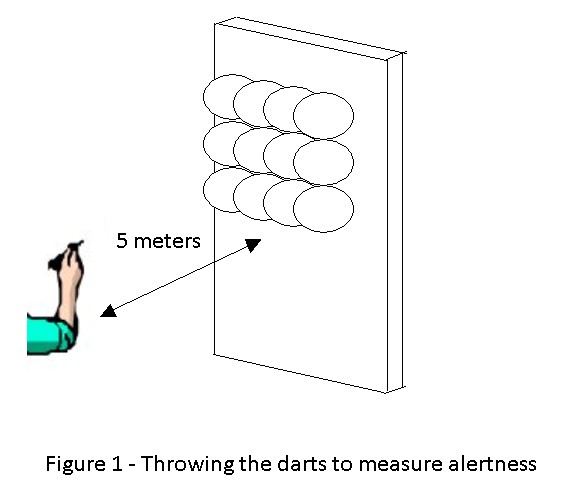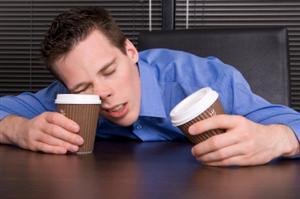| Complexity level: | 4 |
| Project cost ($): | 30 |
| Time required: | 1 hour to prepare, 3 hours for experiment |
| Material availability: | Easily found |
| Safety concerns: | NA |
Hypothesis
Coffee which contains caffeine will make the person more alert and energetic. This will result in the participant being able to burst more balloons.
Overview
What is caffeine?
Caffeine is normally found in coffee and tea. It helps to keep us alert and also prevents us from falling asleep. Caffeine is able to help us stay alert and awake by:
- it increases the level of adrenaline in our bodies, making us more energetic
- it stimulates our brain by increasing the level of dopamine produced
- It prevents us from becoming drowsy.
Scientific Terms
Materials
The materials required for the experiment:
- 480 balloons
- 12 darts
- 1 soft board (approximately 1 meter x 2 meter)
- 1 roll of masking tape
- 10 male and 10 female adults (ages 20 to 30 years old are used)
- 20 cups of caffeinated coffee
Procedure
- For this experiment, the independent variable is the amount of coffee consumed (ie: no coffee, versus having drunk 1 cup of coffee. The dependent variable is the number of balloons burst. This is determined by counting the balloons burst by each volunteer throwing 12 darts. The constants (control variables) are the distance of the thrower from the balloon, the darts, the size, color and type of the balloon and the arrangement of the balloon on the soft board.
- The balloons are prepared by blowing them until they are about 250mm in diameter. They are then arranged in a 4 by 3 arrangment as shown in Figure 1.

- The 20 male and female participants are each given 12 darts to try to burst 12 balloons from a distance of 5 meters. They take turns to burst the balloons before drinking the caffeinated coffee. The burst balloons are replaced after each participant finishes their turn. The number of balloons burst by each of them is recorded in the table given below.
- All of the 20 participants are now made to drink a large cup of caffeinated coffee, and made to wait for 30 minutes.
- The 20 male and female participants again take turns and attempt to burst the 12 balloons using the 12 darts from the same distance of 5 meters. The results are recorded in the same table below for comparison.

Results
You should observe that the participants would become more alert after drinking the caffeinated coffee. They should therefore be able to burst more balloons after drinking the coffee as compared to before they have drunk the coffee.
Use this table below to help record your observations.
| Participant | Balloons Burst (Before coffee) | Balloons Burst (After coffee) | Participant | Balloons Burst (Before coffee) | Balloons Burst (After coffee) |
| Male 1 | 10 | 11 | Female 1 | 8 | 10 |
| Male 2 | 9 | 10 | Female 2 | 7 | 9 |
| Male 3 | 6 | 8 | Female 3 | 7 | 8 |
| Male 4 | 7 | 9 | Female 4 | 5 | 6 |
| Male 5 | 9 | 10 | Female 5 | 8 | 9 |
| Male 6 | 6 | 9 | Female 6 | 9 | 11 |
| Male 7 | 7 | 9 | Female 7 | 6 | 8 |
| Male 8 | 8 | 11 | Female 8 | 7 | 8 |
| Male 9 | 8 | 10 | Female 9 | 8 | 9 |
| Male 10 | 6 | 7 | Female 10 | 7 | 9 |
| Total | 76 | 94 | Total | 72 | 87 |
The male participants had improved their results by 23.6% after drinking the caffeinated coffee. The female participants had also improved their results by 20.8% after drinking the same caffeinated coffee.
Conclusion
The hypothesis is proven to be true. The caffeinated coffee has helped to improve the alertness and energy level of the participants. This has enabled them to improve their aiming and burst more balloons.
Caffeine is found not only in coffee and tea, but also in soft drinks such as Coke. Shift workers and long distance driver depend on such drinks to keep them awake.
Also consider
What would happen if the experiment was conducted by substituting the caffeinated coffee with a caffeinated soft drink?
Try some other activity, like a computer game, throwing balls into a pail or bowling to measure the effects of caffeine.
References
- Caffeine - http://en.wikipedia.org/wiki/Caffeine
- Why does caffeine keep me awake? - http://www.coolquiz.com/trivia/explain/docs/caffeine2.asp

